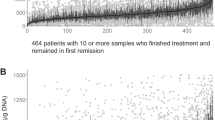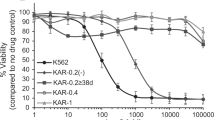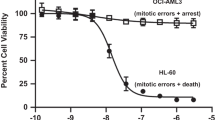Abstract
There is increasing experimental evidence to suggest that endogenous expression of O6-alkylguanine-DNA-alkyltransferase (ATase) is a major factor in cellular resistance to certain chemotherapeutic agents including dacarbazine (DTIC). We have recently shown wide interindividual variation in the depletion and subsequent regeneration of ATase in peripheral blood mononuclear cells (PMCs) following DTIC and this has now been extended to ascertain whether or not depletion is related to dosage of DTIC used and repeated treatment cycles of chemotherapy. ATase levels were measured in three groups of 25 patients (pts) up to 24 h after receiving DTIC at 400 mg m-2, 500 mg m-2 or 800 mg m-2. Each group also received fotemustine (100 mg m-2), 4 h after DTIC. The lowest extent of ATase depletion (highest nadir ATase) was seen in patients receiving 400 mg m-2. The mean nadir ATase, expressed as a percentage of pre-treatment ATase, was respectively 56.3%, 26.4% and 23.9% for 400 mg m-2, 500 mg m-2 and 800 mg m-2. The median nadir of ATase activity for pts receiving 800 mg m-2 pts was at 4-6 h and for pts given lower doses it was at 2-3 h. In addition, repeated measures analysis of variance of observations before chemotherapy, then at 2, 3, 4, 6 and 18 h after chemotherapy provides some evidence that ATase was depleted to a lesser extent after cycle 1 than after subsequent cycles (P = 0.025). It also provides evidence that the change in ATase activity over time varied with dose and cycle. The findings can be interpreted on the basis of a dosage-dependent metabolism of DTIC to an agent capable of methylation of DNA and subsequent depletion of PMC ATase: with higher DTIC doses, the extent of ATase depletion may be limited by the pharmacokinetics of DTIC metabolism. PMC ATase was measured in another group of 8 pts at various times after receiving only fotemustine (100 mg m-2) and in contrast to DTIC, no ATase depletion was seen suggesting that insufficient concentrations of fotemustine and/or its metabolites were available to react with DNA to produce a depletion of PMC ATase activity.
This is a preview of subscription content, access via your institution
Access options
Subscribe to this journal
Receive 24 print issues and online access
$259.00 per year
only $10.79 per issue
Buy this article
- Purchase on Springer Link
- Instant access to full article PDF
Prices may be subject to local taxes which are calculated during checkout
Similar content being viewed by others
Author information
Authors and Affiliations
Rights and permissions
About this article
Cite this article
Lee, S., Thatcher, N., Dougal, M. et al. Dosage and cycle effects of dacarbazine (DTIC) and fotemustine on O6-alkylguanine-DNA alkyltransferase in human peripheral blood mononuclear cells. Br J Cancer 67, 216–221 (1993). https://doi.org/10.1038/bjc.1993.42
Issue Date:
DOI: https://doi.org/10.1038/bjc.1993.42
This article is cited by
-
“One week on–one week off”: efficacy and side effects of dose-intensified temozolomide chemotherapy: experiences of a single center
Journal of Neuro-Oncology (2013)
-
Fotemustine plus etoposide, cytarabine and melphalan (FEAM) as a new conditioning regimen for lymphoma patients undergoing auto-SCT: a multicenter feasibility study
Bone Marrow Transplantation (2010)
-
O6-(4-bromothenyl)guanine reverses temozolomide resistance in human breast tumour MCF-7 cells and xenografts
British Journal of Cancer (2005)
-
Marked inactivation of O6-alkylguanine-DNA alkyltransferase activity with protracted temozolomide schedules
British Journal of Cancer (2003)
-
Sequential therapy with dacarbazine and carmustine: a phase I study
Cancer Chemotherapy and Pharmacology (1994)



